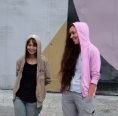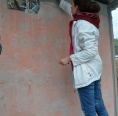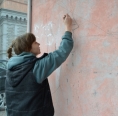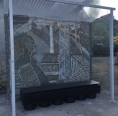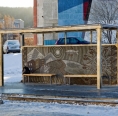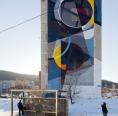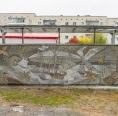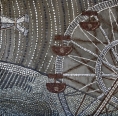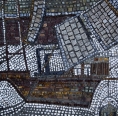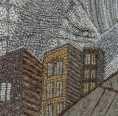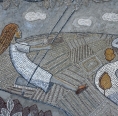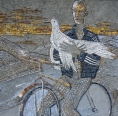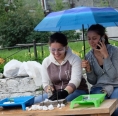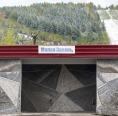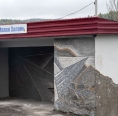-
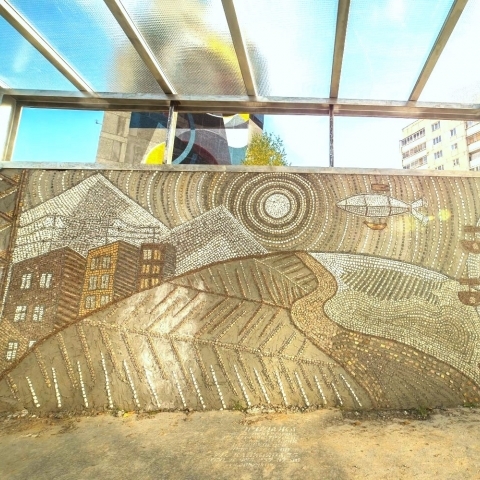
MOSAICS AT THE BUS STOPS
MARIYA LARICHEVA AND MARIYA VOLOKHONSKAYA
-
Address:
-
Partners:
Mariya Laricheva and Mariya Volokhonskaya are the Moscow artists; they made mosaics out of the local rock formations at four bus stops in Satka.
In 2017, in the framework of the second architectural festival “My Satka”, Mariya Laricheva and Mariya Volokhonskaya decorated Vokzal bus stop in the core city with a mosaic called “A Man and a Bird” with the active involvement of the local volunteers. In 2018, in the framework of the third architectural festival “My Satka”, the artists made a large-scale and detailed mosaic in Satka – stone canvases “Autumn. Airship” and “A Summer Day in Satka” in the Zapadniy microdistrict. In 2021, the artists decorated one more bus stop in Pervomaiskiy settlement. Due to the vicinity of Karginskiy Park, the artists dedicated their mosaics to the connection between a man and nature. In 2022, Mariyas made the “Shiplet” mosaic at Malaya Zapan bus stop.
2017
Another season of the architectural festival had come to an end in Satka. Both foreign experts and volunteers who care about the city’s look took part in the festival. They joined their forces and added some interesting facilities to the city over the past few months.
Large-scale changes began this year since May 21. Providers of My Satka Festival invited architects, designers and street artists from Russia, Italy and Switzerland. A lot had to be done this season: putting to rights the things that were created a year ago and implementing fresh ideas. Festival curator Egor Larichev does not conceal: participants ventured to tackle more large-scale projects, and it was a right decision.
Now, all or almost all festival participants have photos with sphinxes. The wooden figures on the festival sites symbolize coming changes which will affect the city environment of Satka.
A concrete dolmen appeared on the city pond embankment: Swiss designer Dimitri Bähler, with the help of volunteers, decorated the wall with dolomite and magnesite mosaic. The wall subsequently transformed into an unusual public transport stop. Mosaic technique was also used in another stop of the city. Its sketch was offered by Moscow artist Maria Volokhonskaya.
Then man-size vases were installed on the embankment. The authors – Swiss designers Adrienne Rovero and Christoff Fuad – designed the vases to resemble blast furnaces. Due to CEO of the botanic garden of the Chelyabinsk State University Vera Merker, the giant flower pots received “inhabitants” – trees which are highly adaptive to the Ural climate.
So-called Ruina – an abandoned place near Magnezit Cultural Center left after demolished residential house – became another festival site. Moscow architect Igor Aparin from Kontora bureau tackled the Ruina. Wooden pallets, wire mesh and large-fraction rock – and the site becomes a place for mass city events. The Ruina can be easily transformed depending on the format of events. Neighbour’s Fair and the photo exhibition of the Swiss architect and photographer An-Lor Le Sha were already held here. The Ruina also hosted the Fantasy street art exhibition. To surprise of the audience, works of fifty modern artists were exhibited open air.
This year, My Satka Festival was coordinated by Sobranie Cultural Initiative Supporting & Preservation Fund, the municipal government, Pro Helvetia, the Swiss Arts Council, and the Istituto Italiano di Cultura in Moscow. However, an event of such level would be impossible without contribution of dozens of volunteers and their teachers. Together, they proved that everyone can change ambient space for the better. That means than My Satka Festival will certainly return in 2018.
2018
In August-September-October the town hosted "My Satka" festival of urban development which participants included artists, designers and architects from Moscow, Krasnoyarsk, Ekaterinburg and Chelyabinsk as well as foreign guests actively supported by the town volunteers.
More than twenty-day marathon on creation of two side monumental decoration of the public taxi bus stop in Zapadny microdistrict held by Moscow muralists Maria Volokhonskaya and Maria Laricheva was accompanied by activities of Street Mosaic School − open lessons, work with the material, open-air practice.
It resulted in two mosaic boards of the total area of 25 square metres devoted to the metaphysics of spatial movement. The mosaics are made from the minerals found in Satka region: apart from magnesite and dolomite usual and well-known to Satka people by industrial sites and dumps, siderite, brucite, iron clay and even exotic bauxite − the source of aluminium and rare metals − are found here.
The taxi bus stop project is developed by Moscow architect Dmitry Baryudin, already known to Satka people by the architecture of "Magnezit" museum, wooden sphinxes decorating the banks of the town pond and Ruina square enclosed with mesh walls.
Another monumental object − mosaics of Aleksandra Spiridonova, a graduating student of Stroganov Academy − was carried over with the help of volunteers to the wall of a transformer vault in the centre of Satka. The brilliant general formula of the decoration allowed the volunteers to make their own creative contribution.
At the end of October 2018, a sculpture made by Alexey Luchko, known in the street art world as Luka, appeared near the lower gate of Magnezit Group industrial site leading to the former BelAZ repair shop. The combination of the textures of the seven-metre architecton made of two cubes placed one on another reminds Satka people about the stalls used to be a part of urban landscape not long ago.
Luka's piece of architecture will mark the entrance to the territory which starting from this year will become a driver of urban changes in Satka. Famous BelAZ repair Hangar already valued by the town people on the Steel Worker Day and the surrounding area will become a place of cultural activities of the town and Magnezit Group starting from the beginning of summer.
To examine the potential of the site and sum up all ideas of the last years on its development, "Hangar 18" project workshop was organized in the beginning of August which gathered architects Dmitry Baryudin, Mikhail Labazov and curator of the festival architectural part Egor Larichev, the writer of these words.
In addition to the area development concept for the next year, an action plan on ‘shock’ humanization of the area in the scope of the festival 2018 was prepared. The façade of the large Hangar building was decorated by Luka’s graphic art, the lighting tower − with abstract pattern of Zedz, a Dutch artist, whose robots also decorated the side face of the hangar. Colour cable reels appeared in the surrounding area. During already traditional Pere-satka campaign, a group of dendrologists of the Chelyabinsk State University headed by Vera Viktorovna Merker and Satka volunteers tubbed the plants to be used for ‘green navigation’ in the area surrounding the Hangar. Oxygen Cabin appeared in front of the Hangar. It is a small gallery of street art with step amphitheatre made by Denis Ilbeykin, a wood craftsman from Sovetskaya Gavan town. The first exhibition was the personal show of Vasya Suslov, an eight-year old Satka artist inspired by German street artist Hendrik.
"Two Spirits" sculptural group by Swiss sculptor Florian Graf, the participant of the 4th Industrial Biennale in Ekaterinburg, manufactured from refractory concrete by the Department of Innovative Products of Magnezit Group, made as anthropomorphous columns resembling a matrioshka doll and installed in the framework of the festival, were silently but as if sympathetically watching the collective efforts of the festival participants on rearrangement of the area near the Hangar. Silent stones of the garden also arranged here seemed to be waiting for their turn to talk to Satka people. Tables and chairs from pallets, "U Robota" open bar, a large bench near the Hangar entrance completed the picture of instantaneous landscaping full of spontaneity, hedonism and belief in the possibility of changes.
The final of the festival turned to be symbolical: Alexsandr Zakirov, an abstract artist from Krasnoyarsk, installed, with physical support of the festival curator, letters "My Satka" on a travelling bridge inside the Hangar. So, the fact was symbolically established: now Satka festival has its home and, to be precise, not just a home, but an entire Hangar. As for the exact meaning of the symbol, we will know it soon. ‘The experience of spontaneous humanization of a post industrial area’ turned to be exceptionally productive. Thanks to all of you!
This year, the festival was held under the support of Satka Municipal Administration, "Sobranie" Cultural Initiative Supporting & Preservation Fund and the President Grants Fund.
2021
Moscow artists Mariya Volokhonskaya and Mariya Laricheva finished the mosaic that now decorates new Pervomaiskiy bus stop (near the city park).
– It’s been three weeks, without preparatory works. We worked even in snowy and cold weather. It was awesome! – briefly commented Maria Laricheva on the result of the works. Let us recall, the mosaic made of local materials, mainly magnesium carbonate, dolomite and brucite, addresses the topic of the nature and human. The artists made a split work – it is a kind of diptych with two subjects. In the center of the first one, there are a human and a bird, and the main character of the second one is a girl on the swings. "They seem to be reaching out to each other. And there is a feeling of an open book or screen curtain" – said the authors.
In the near future, the bus stop complex will be developed to be more functional.
2022
The artists Mariya Laricheva and Mariya Volokhonskaya completed the decoration of Malaya Zapan bus stop with a mosaic made out of local rock formations.
The new mosaic art-object was called “The Shiplet”. By the way, the main character is made out of snow-white Siberian magnesite. Dolomite and diabase served as an addition to the stone palette.
The idea of “decorating” the wall of the bus stop with a stone river, which forms the picture dominant – a paper shiplet – is explained by the surroundings. According to Mariya Volokhonskaya, the bus stop has a sufficiently intense and dynamic background - trains go behind it, a pond, mountains, and a forest…
“Sketching, we went off of the local conditions and the landscape,” says Mariya Volokhonskaya. “I wanted to make a sufficiently big, but simple object, solid and consisting of a number of elements. That’s how the shiplet appeared, it was a formal solution: the most part of the mosaic is on different planes due to the object construction, but in the distance the picture seems to be an integral whole.”
We got a double picture: the face walls of the bus stop partly repeat the contour of the shiplet, which occupies almost all space on the internal wall. By the way, this was the part of the work visited and shared with the young geologists.
“Cool guys, they raised our spirits a little, eagerly asked us about the work, tried splitting stones and arranging the mosaic – small, active and cheerful children. Nikolay, a local, former BelAZ driver, also visited us, treated us to coffee and cheered us up – special thanks for his kindness and care,” said Mariyas and added that the weather also gave the impressions. Especially on the last day, there was a snow fall.
“At first, that’s good that it started falling in the end of our work. And at second, it was very beautiful! Everything made the integral array: our mosaic — in white-yellow and beige colors — against the background of white snow in the autumn forest. Looks effective!”
It was the moment caught by our photographer. When we look at the bus stop from the opposite side of the road from a greater distance, an illusion is created that a white shiplet dances on the waves of the autumn scenery.
OUR INFO:
The work was created with the assistance of Sobranie Fund, Magnezit Group and the Satkinsky district administration. It is the fourth bus stop decorated in Satka by Mariya Laricheva and Mariya Volokhonskaya. The fifth object, which is also a mosaic made of local rocks, was created by the Swiss artist Dimitri Beller, who worked together with volunteers at Moya Satka festival in 2017.
-
2025
Lecture series on art
-
2012
The Russian Museum. Satka
-
2019
MAMM

